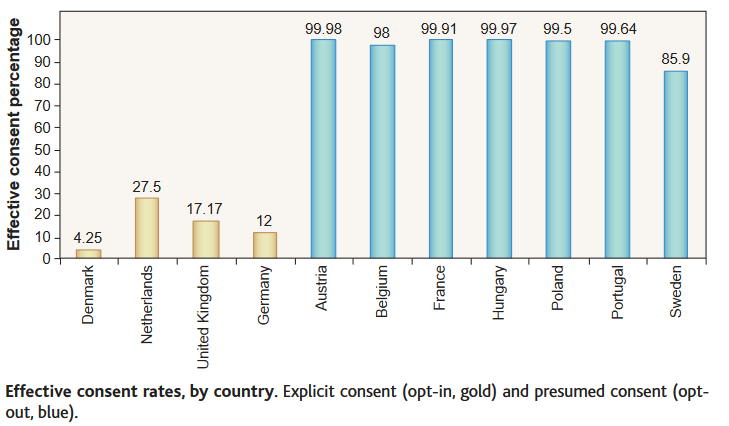Presumed Consent in Wales Falls Short
In 2003, Johnson and Goldstein published what would become a famous paper in Science, Do Defaults Save Lives? The paper featured a graph which showed organ donor consent rates in opt-in countries versus those in opt-out countries. The graph is striking because it seems to suggest that a simple change in the default rule can create a massive change in organ dono r rates and thus save thousands of lives.
r rates and thus save thousands of lives.
The graph, however, does NOT show organ donor rates. It shows that in opt-in countries few people explicitly opt-in and in presumed consent countries few people explicitly opt-out. But when a potential organ donor dies the families of people in opt-in countries who did not opt-in are still asked whether they would like to donate their loved one’s organs and many of them say yes. Similarly, in the presumed consent countries the families of people who did not opt-out are still typically asked whether they would like to donate their loved one’s organs and some of them say no.
The actual difference in organ donation rates between opt-in and presumed consent countries is much smaller than the differences in the graph, as Johnson and Goldstein made clear later in their paper. Nevertheless, the simple story in the graph encouraged many people to put excess weight on presumed consent as the solution to low organ donor rates.
The best estimates of presumed consent suggested that switching to presumed consent might increase organ donor rates by 25%. 25% isn’t bad! But we don’t have many examples of countries that have switched from one system to another so that estimate should be taken with a grain of salt.
The latest evidence comes form Wales which switched to presumed-consent in 2013. Unfortunately, there has been no increase in donation rates.
The most significant analysis of the new system is the Impact Evaluation Report, released by the Welsh Government in November 2017. Whilst focusing on the positives, such as increased understanding among medical staff, the report cannot escape the donation statistics, which clearly show no improvement. Covering the period from January 2010 or January 2011 to September 2017, all donation data show no change since the legislation’s introduction. The 21-month period before the Act came into effect saw 101 deceased donors, whereas the same period after showed 104; an increase, but one that can be properly attributed to expected annual fluctuation.
I still favor presumed consent or better, mandated choice, but I don’t think the binding constraints on organ donation are default rules. More important are preferences and fears about donation, the existence of a professional system using people who are trained to ask for donations, an institutional organization that can use donations when they are available (minimizing waste), and, of course, incentives.
Hat tip: Frank McCormick.